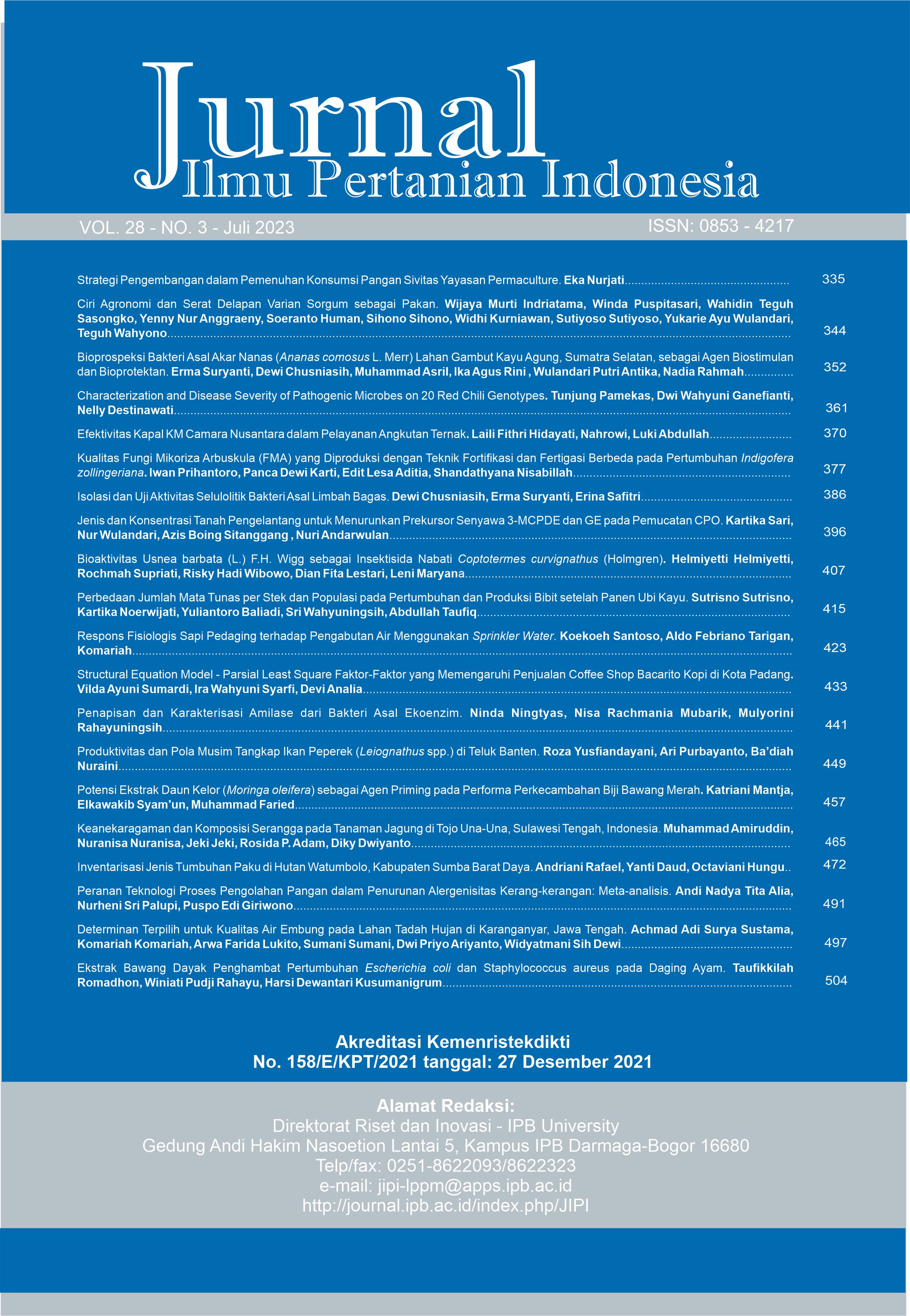Characterization and Disease Severity of Pathogenic Microbes on 20 Red Chili Genotypes
Abstract
Pathogenic microbes are the limiting factor in increasing red chili productivity. These pathogens cause decreasing yield of red chili up to 50-100%. This research aimed to characterize and evaluate disease severity on 20 red chili genotypes caused by pathogenic microbes. The research was arranged in Randomized Complete Block Design with three replications. The samples were 20 chili genotypes, namely UNIB K01, UNIB CGTS1, G35, G48, G56, G60, G67, G77, and G43 (developed by the University of Bengkulu researchers) and IPB C19, COPAY, IPB C495, IPB C14, DORSET NAGA, IPB C4, IPB PANJANG, LOKAL BENGKULU, SELOKA, SSP, and ANIES (developed by others). The results showed that four groups of pathogens attacked red chili, namely Fusarium oxysporum, which causes fusarium wilt disease; Cercospora sp., the cause of leaf spot disease; Colletotrichum sp. causes anthracnose; and virus groups. All tested red chili genotypes could be infected by these four pathogens in which the incubation period, disease incidence, and disease severity were insignificant. Of the nine genotypes developed by the University of Bengkulu researchers, the G35 genotype had the best potency to be developed as a disease-resistant genotype.
Keywords: Cercospora sp, Colletotrichum sp, Fusarium s, virus
Downloads
References
Kementerian Pertanian. 2015. Produktivitas cabai besar dan cabai rawit 20112015. [internet] [Diakses pada 29 Maret 2017]. Tersedia pada: http://www.pertanian.go.id. Kementrian Pertanian RI.
Barnett HL, Hunter BB. 2000. Illustrated Genera of Imperfect Fungi. Edisi ke-3. Buergess Publishing Company.
Dewi AA, Ainurrasjid D, Saptadi. 2016. Identifikasi ketahanan tujuh genotipe cabai rawit (Capsicum frutescens L.) terhadap patogen penyakit. Jurnal Produksi Tanaman. 4(3): 174176.
Domsch KH, Gams W, Anderson TH. 1980. Compendium of Soil Fungi. V1. IHW-Verlag. 305799 p.
Ferryansyah. 2014. Pengujian konsentrasi kultur filtral jamur Fusarium oxysporum pada resisten tanaman kentang (Solanum tuberosum) terhadap penyakit layu Fusarium. [Skripsi]. Bengkulu (ID): Universitas Bengkulu.
Ganefianti DW, Sujiprihati S, Hidayat SH, Syukur M. 2008. Metode penularan dan uji ketahanan genotipe cabai (Capsicum spp.) terhadap Begomovirus. Aktaagrosia. 11(2): 162169.
Gunaeni N, Kirana R, Sofiari E. 2014. Keragaan derajat toleransi beberapa galur cabai merah (Capsicum annuum L.) terhadap penyakit virus kuning keriting di daerah endemi. Agrin.18.
Nugraheni ES. 2010. Karakteristik biologi isolate-isolat Fusarium sp pada tanaman cabai merah (Capsicum annum) asal Boyolali. [Skripsi]. Surakarta (ID): Universitas Sebelas Maret.
Semangun H. 2001. Pengantar Ilmu Penyakit Tanaman. Yogyakarta (ID): Gajah Mada University Press.
Semangun H. 2004. Penyakit-Penyakit Tanaman Hortikultura di Indonesia. Yogyakarta (ID): Gajah Mada University Press.
Setiadi. 2011. Bertanam Cabai. Jakarta (ID): Penebar Swadaya.
Subekti D, Hidayat SH, Nurhayati E, Sujiprihati S. 2006. Infeksi Cucumber Mosaic Virus dan Chili Veinal Mottle Virus terhadap pertumbuhan dan hasil tanaman cabai. Hayati. 13(2): 5357. https:// doi.org/10.1016/S1978-3019(16)30381-3
Sudirga KS. 2016. Isolasi dan identifikasi jamur Colletotrichum spp. isolat Pcs penyebab penyakit antraknosa pada buah cabai besar (Capsicum annuum) di Bali. [Skripsi]. Denpasar (ID): Universitas Udayana.
Sujatmiko B, Sulistyaningsih E, Murti RH. 2012. Studi ketahanan melon (Cucumis melo L.) terhadap layu fusarium secara in-vivo dan keikatannya dengan asam salisilat. Jurnal Ilmu Pertanian. 15(2): 118.
Sugiharso B. 1983. Dasar-dasar Perlindungan Tanaman. Departemen Ilmu Hama dan Penyakit Tanaman. Bogor (ID): IPB Press.
Syukur M, Sujiprihati S, Koswara, J. 2009. Ketahanan terhadap antraknosa yang disebabkan oleh Colletrichum acutaum pada beberapa genotipe cabai (Capsicum annum L.) dan korelasinya dengan kandungan kapsaicin dan peroksidase. Jurnal Agronomi Indonesia. 37(3): 233–239.
Taufik M, Hidayat SH, Suastika G, Sumaraw SM, Sujiprihatin S. 2005. Kajian plant growth promoting Rhizobacteria sebagai agens proteksi cucumber mosaic virus dan chilli veinal mottle virus pada cabai. Hayati 12(4): 139144. https:// doi.org/10.1016/S1978-3019(16)30341-2
Trisno J, Hidayat SH, Jamsari, Habazar T, Manti I. 2010. Identifikasi molekuler Begomovirus penyebab penyakit kuning keriting pada tanaman cabai (Capsicum annum L.) di Sumatra Barat. Jurnal Natur Indonesia. 13(1): 4146. https://doi.org /10.31258/jnat.13.1.41-46
This journal is published under the terms of the Creative Commons Attribution-NonCommercial 4.0 International License. Authors who publish with this journal agree to the following terms: Authors retain copyright and grant the journal right of first publication with the work simultaneously licensed under a Creative Commons Attribution-NonCommercial 4.0 International License. Attribution — You must give appropriate credit, provide a link to the license, and indicate if changes were made. You may do so in any reasonable manner, but not in any way that suggests the licensor endorses you or your use. NonCommercial — You may not use the material for commercial purposes.























